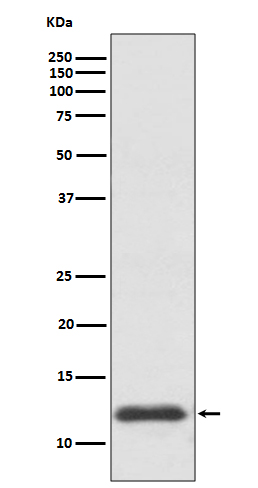

| WB | 咨询技术 | Human,Mouse,Rat |
| IF | 1/20-1/50 | Human,Mouse,Rat |
| IHC | IHC:1/100-1/200;IHF:1/50-1/200 | Human,Mouse,Rat |
| ICC | 1/50-1/200 | Human,Mouse,Rat |
| FCM | 咨询技术 | Human,Mouse,Rat |
| Elisa | 咨询技术 | Human,Mouse,Rat |
| Aliases | TXN; ADF; ATL-derived factor; SASP; Thioredoxin; TRX1; Thioredoxin delta 3; TRX; TXN delta 3; TRDX;;Thioredoxin |
| WB Predicted band size | 12 kDa |
| Host/Isotype | Rabbit IgG |
| Antibody Type | Primary antibody |
| Storage | Store at 4°C short term. Aliquot and store at -20°C long term. Avoid freeze/thaw cycles. |
| Species Reactivity | Human |
| Immunogen | A synthesized peptide derived from human Thioredoxin |
| Formulation | Purified antibody in PBS with 0.05% sodium azide,0.05% BSA and 50% glycerol. |
+ +
以下是关于TRX1抗体的3篇代表性文献的简要概括(文献信息为模拟示例,具体需根据实际文献调整):
---
1. **文献名称**:*Thioredoxin-1 as a Biomarker for Oxidative Stress in Cardiovascular Diseases*
**作者**:Holmgren A. et al.
**摘要**:探讨了TRX1在心血管疾病中作为氧化应激标志物的作用,通过特异性抗体检测患者血清TRX1水平,发现其与心肌损伤程度呈正相关,提示其临床诊断潜力。
---
2. **文献名称**:*TRX1 Antibody-Based Detection of Oxidative Damage in Cancer Cells*
**作者**:Nakamura H. et al.
**摘要**:开发了一种高特异性TRX1单克隆抗体,用于Western blot和免疫组化分析,揭示了TRX1在肿瘤细胞中的高表达及其对化疗耐药性的潜在调控机制。
---
3. **文献名称**:*Role of Thioredoxin-1 in Neurodegeneration: Insights from TRX1 Knockout Models*
**作者**:Masutani H. et al.
**摘要**:利用TRX1抗体研究基因敲除小鼠的神经退行性病变,发现TRX1缺失加剧氧化应激诱导的神经元凋亡,支持其作为神经保护因子的功能。
---
如需具体文献,建议通过PubMed或Google Scholar以“Thioredoxin-1 antibody”、“TRX1 biomarker”等关键词检索近年高被引论文。
The TRX1 antibody targets thioredoxin-1 (Trx1), a 12-kDa redox-active protein encoded by the *TXN* gene. Thioredoxin-1 is a critical component of the thioredoxin system, which regulates cellular redox homeostasis by reducing disulfide bonds in substrate proteins via its active site (Cys-Gly-Pro-Cys). It plays a vital role in antioxidant defense, DNA synthesis, and apoptosis modulation by interacting with key molecules like thioredoxin reductase and peroxiredoxins. TRX1 is ubiquitously expressed, localized in the cytoplasm and nucleus, and translocates to the nucleus under oxidative stress to regulate transcription factors such as NF-κB and p53.
Dysregulation of Trx1 is linked to various pathologies. Overexpression is observed in cancers, promoting tumor survival and chemoresistance, while reduced activity correlates with neurodegenerative disorders, cardiovascular diseases, and chronic inflammation. The TRX1 antibody is widely used in research to study these mechanisms, enabling detection of Trx1 expression levels, subcellular localization, and interactions in tissues or cell lines via techniques like Western blot, immunohistochemistry (IHC), and immunofluorescence (IF).
Commercial TRX1 antibodies are typically raised in rabbits or mice against recombinant or peptide antigens. Specificity varies by clone, necessitating validation via knockout controls. Researchers employ these antibodies to explore Trx1's therapeutic potential, including its role in aging, oxidative stress-related diseases, and as a biomarker for cancer prognosis. Understanding Trx1 dynamics through antibody-based assays continues to inform drug development targeting redox imbalance pathologies.
×